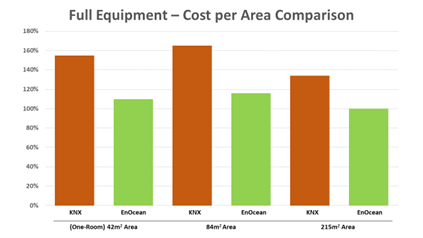Smart work environments for SMEs

Wired or wireless technology: Which is better for connected buildings?
Intelligent work environments with demand-driven regulation of temperature, air quality, and lighting can have a positive effect on the comfort and well-being of employees, thus increasing their motivation and productivity. The things that large companies do in their smart spaces are becoming increasingly easier to implement on a smaller scale. The hardware alone, however, does not make a space smart. It is the type of networking that counts: wired or wireless. A new study by Rosenheim Technical University of Applied Sciences compares the common KNX and EnOcean standards in different scenarios. The study’s findings can also be applied to intelligent commercial spaces.
When people feel good, they work with greater commitment and productivity. Many larger companies have long understood this connection. They rely on intelligent office spaces – referred to as smart spaces – and sensor-based infrastructure management. This infrastructure management system collects sensor-generated building condition data and uses it for adjustments or analyses. This makes it possible to monitor and control important factors influencing employee productivity and office hygiene – such as temperature, air quality, lighting conditions, and cleanliness – based on the number of people in the building. Smart spaces thus form an interface between people and their work environment and add a virtual component to the physical workspace.
The things that are increasingly being implemented on a large scale can also be realized on a small scale. For the first steps towards intelligent buildings, SMEs can use smart building functionalities that are easy to install or retrofit to upgrade commercial spaces, offices, or practices.
Different standards
Digital networking is the prerequisite for intelligent buildings because it is the only way to enable smooth communication between the individual components. This can take place in two different ways by using either wired or wireless technology. In addition to proprietary solutions from individual manufacturers, there are also open standards for both variants. KNX (wired) and EnOcean (wireless) are each representative in their segment.
KNX (Konnex) is a widely used wired bus system for building automation. As a further development of the EIB (European Installation Bus), KNX is an open, manufacturer-independent standard that is supported by a large number of manufacturers. As a standardized standard, KNX leaves a great deal of room for design and is considered to be particularly secure.
EnOcean was defined in 2012 by the International Electrotechnical Commission (IEC) as a global wireless standard (ISO / IEC 14543-3-10) for decentralized building automation. Today, more than a million buildings have such radio networks. The EnOcean ecosystem of self-powered wireless sensor solutions currently consists of 5,000 product variants based on 1,500 basic products. The products can be combined with one another using standardized interoperable sensor profiles.
Wired or wireless technology in intelligent buildings?
The study[1]by Julia Winkler (B.Eng.) and Prof. Dr. Michael Krödel examines this question. It compares intelligent areas of different sizes based on KNX or EnOcean technology in two equipment variants with regard to costs, sustainability as well as health and well-being. In both cases, a conventional building without intelligent networking serves as a reference value.
Specifically, this involves the following:
- A single-room area of 42.3 m2 and a total of 33 or 42 components (basic or full equipment)
- A medium-sized area of 83.5 m2 and a total of 70 or 89 components
- A large area of 215.2 m2 and a total of 162 or 186 components
The equipment in conventional buildings is based on the 18015-RAL-RG678 DIN standard for the installation of electrical systems in residential buildings. The differentiation of the smart building variants is based on the results of internal university research. The basic equipment includes typical entry-level functionalities for comfort, safety, and energy conservation. Along with the basics, the full equipment version comprises additional lighting, heating, and security functionalities. The cost calculation for the individual equipment options is based on a calculation aid for electrical and information technology trades as well as the current product catalogs of representative providers, such as Hager (for KNX) and Eltako (for EnOcean).
Smart costs – wireless is cheaper by comparison
A comparison of a conventional installation with smart equipment reveals an unsurprising picture: Smart initially costs more. According to the study, the extra charge for the electrical installation is between 64% in the single-room area with basic equipment based on EnOcean technology and 385% in the medium-sized area based on KNX[2].
When comparing the “wired” (KNX) or “wireless” (EnOcean) variants, wireless solutions come out on top in terms of costs. With comparable functionality, the difference is 20 to 30 percent. This applies to all equipment variants. Reasons for this include the higher expense of cabling as well as the costs for the components and their installation.

By contrast, maintenance-free wireless sensors require neither mains power nor batteries. Thanks to energy harvesting technology, they draw their energy from the environment (kinetic energy, pressure, light and temperature differences). Wireless sensors can be installed anywhere they are needed. This saves time and money during installation and operation while also paving the way for quick and easy retrofitting in existing buildings.
Conclusion
It is true that intelligently networked areas initially cost more. But these investments pay off in the medium and long term, even for SMEs, in terms of the increase in comfort and well-being as well as lower energy costs. The installation costs of wireless smart offices are as much as one third less than the equivalent wired version. They also earn high marks in terms of flexibility and environmental protection.
[1] Winkler, J. (2021). Comparison of KNX and EnOcean using room automation installations as examples with regard to costs and ecological aspects as well as taking into account a user-oriented requirements profile. (Bachelor thesis). Rosenheim Technical University of Applied Sciences, Germany.
[2] Overall, it should be noted that all variants of KNX incur costs for Engineering Tool Software (ETS) and license fees in addition to materials and installation.




